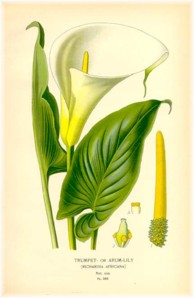Calm Calla
By Audrey Stallsmith

"This room is ever so much improved every time I come, though I hardly see what it is except the flowers," said Ralph, looking from the girl to the tall calla that bent its white cup above her as if to pour its dew upon her head.
Louisa May Alcott--Jack and Jill
The simple, elegant lines of the calla lily were popular even in the "fussy" Victorian era, when more opulent blooms prevailed. So fashionable did the "arum lily" prove for funerals, in fact, that it soon came to represent them in many minds.
In fact, it took a courageous gardener to grow calla indoors, as a "blasted" bud supposedly presaged a death in the house. Even a successful bloom indicated that you would attend a friend's last rites. And, although the Arabs hold that a black calla will keep you healthy, break or cut that plant and your doom is sealed!
On a brighter note, the early Romans brought calla's "candles" indoors to symbolize the return of light at the winter solstice. And their pristine elegance has endeared the blooms to brides too. So much so that the white calla has come to stand for "magnificent beauty" in the language of flowers.
Not that the whitest part is really a flower. It is actually a spathe--a type of leaf. The tiny--and yellow--actual blooms spiral around the central yellow spike (spadix).
Fortunately most brides don't know that their bouquet flower has also been called pig lily, since its rhizomes are attractive to wild hogs. And, as an aroid, the plant is actually a relative of skunk cabbage.
It prefers similar conditions, having originated in the swampier areas of eastern and southern Africa. The most common white type was originally known as Calla aethiopica until scientists discovered that it wasn't actually a calla. (Nor a lily either for that matter!) For a time it was called Richardia africana after British botanist Richard Richardson. But it eventually came to be known as Zantedeschia aethiopica in honor of Italian botanist Giovanni Zantedeschi.
Calla can reportedly only be eaten if boiled first, as it contains calcium oxalate crystals, and so is somewhat toxic when raw. And, although its large leaves have been used as poultices, they can irritate sensitive skin.
So, in the case of this flower, it's best to just look, not lunch! These days, the calla is available in a wide range of lovely colors and sizes. If you live in the north, however, be sure to bring those rhizomes indoors over the winter. Although most aren't hardy, they can make lovely houseplants--for those not bothered by old superstitions!
Richardia africana image is from Favorite Flowers of Garden and Greenhouse by Edward Step and William Watson.








